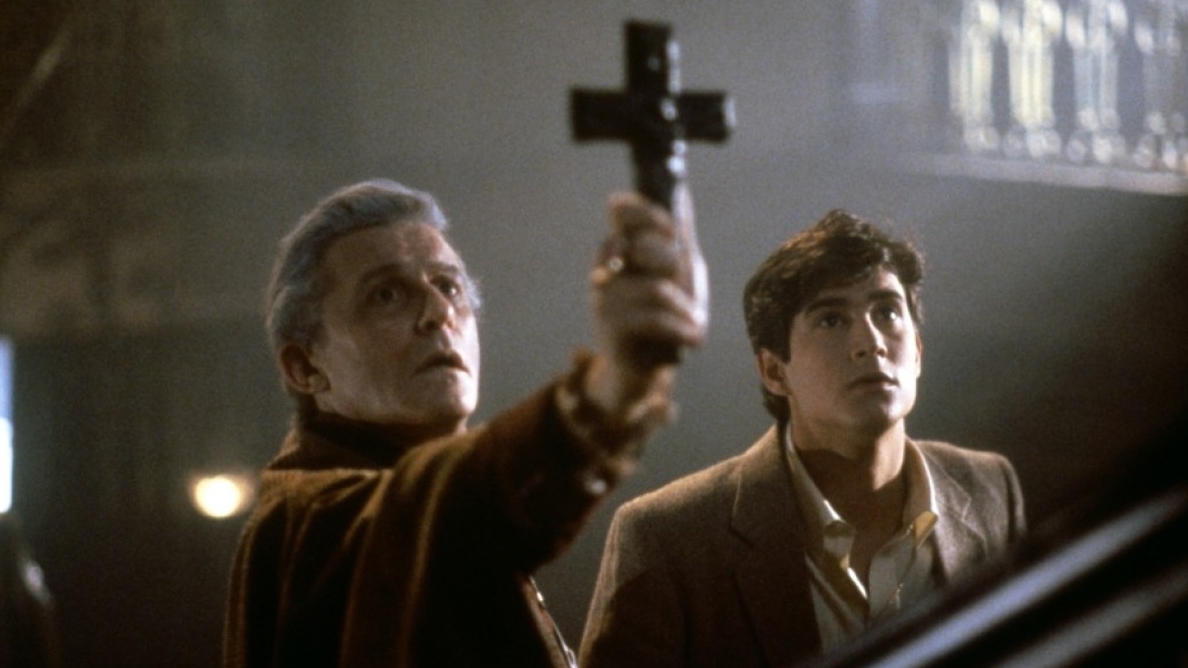The Patience for Vampires: Fright Night (1985)
Director Tom Holland’s (not the actor) Fright Night begins with a pan into a teenage boy’s room. The theme music to a schlocky horror program hosted by a Vincent Price mimic blares from the tinny speakers of his television set. In the show, Roddy McDowall, as the famed horror leading man Peter Vincent, slays vampires by driving stakes through their hearts. The scene within a scene sets the tone for Fright Night beautifully; it’s silly, b-movie fun filled with nostalgia for the classic horror of the days of Bela Lugosi.
Seventeen-year-old Charley Brewster, an avid horror fan, begins to suspect his new neighbor is a vampire when he sees something frightening through his bedroom window. As more and more locals begin to disappear, Charley suspects the neighbor, Mr. Dandridge, whom he hopes to expose as a vampire with the aid of his friend, girlfriend, and the local actor Peter Vincent.
Perhaps the most remarkable thing about Holland’s incredibly fun and funny horror movie is how well it manages to meld the old with the new. This is a film that is simultaneously looking back to the seductive Draculas of yore while also weaving a distinctly post-Hitchcockian tale. In short, this is Rear Window with vampires. All of the Cold War era paranoia and intrigue serves as a vehicle to catapult us into the clutches of Chris Sarandon’s Mr. Dandridge.
Charley’s paranoia and horror at what is going on next door begins as, essentially, the butt of a multi-part joke. Charley sees something creepy or grotesque then alerts his mother, a friend, law enforcement, etc. Dandridge acts completely normal and Charley is painted as a paranoid idiot. This cycle repeats over and over with each secondary character. And, as Holland invents more and more ludicrous scenarios to parade Charley and company through, culminating in Dandridge’s hypnotic dance club seduction of Charley’s girlfriend Amy, we wait to see just how big the bubble can get before it bursts. How long until they see what we see? Similar to Hitchcock, Holland waits until the end of the last act to let that bubble burst and put everyone on the same page.
When that bubble bursts, Holland goes full An American Werewolf in London. Richard Edlund’s (Ghostbusters) brilliantly inventive prosthetics and practical effects work let the grotesquely horrors of the Dandridge household absolutely sing. Green goop, elongated digits, and morphing feet all work to create set-piece moments that hold up beautifully today. In one particularly bravura transformation sequence, a creature is shown transforming back into something else and Holland cuts and frames the scene to keep us constantly filling in the blanks, creating an off screen tension I haven’t experienced outside of The Thing or An American Werewolf in London. It’s pretty masterful stuff and it amazes even thirty years on.
In the end, for all of Fright Night’s schlocky fun and seductive vampires, Holland seems to be making a relatively serious and interesting statement on Cold War paranoia. Though Brewster’s dogged investigations do end up circuitously solving the Dandridge problem, it’s faith that ends up winning the day. When Charley finally succeeds in getting Vincent’s attention and sincere advice, he is told to arm himself with holy water and crucifixes. It’s a tried and tested trope in vampire fiction. Next to garlic and stakes, the most iconic weapon against a vampire is a simple cross or a dab of sanctified water. And, in the climax of the film, Holland drives home this emphasis on faith in particularly blunt fashion. When Brewster holds up a crucifix against Dandridge in defense, Dandridge mocks him saying, “That only works if you have faith!”
Midway through the film when Charley first requests Vincent’s help, Vincent chides, “The kids today don't have the patience for vampires. They want to see some mad slasher running around and chopping off heads.” It’s a statement that is steeped in nostalgia, yearning for the days of the classic Universal monster picture. And, in many ways, Holland reflects this preoccupation with the old in his choice of subject: vampires, and in his ultimate stance: faith is the most powerful weapon against evil. But, the route he takes to get to this conclusion is certainly a distinctly contemporary one. It’s one which examines old stories through new fears—subversion, covert harm, and a hidden ‘other’ in the neighborhood. It’s a film that can never escape the past greats to which it is deeply indebted, but also reflects the contemporary malaise in which it finds itself mired. In other words, it does everything a horror film is supposed to do: tap into what has always scared us while helping us make sense of the ambiguity that plagues our daily existence.




